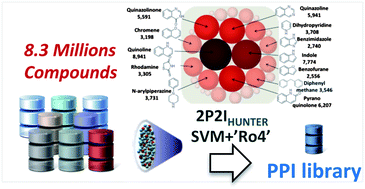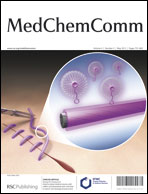2P2Ichem: focused chemical libraries dedicated to orthosteric modulation of protein–protein interactions†
Abstract
We have recently developed a 2P2IHUNTER learning machine tool for filtering potential orthosteric PPI modulators. In the present research article we applied our algorithm to 8.3 million compounds representing the main chemical providers commercially available to design a PPI-focused library, 2P2IREF, composed of 143 218 small molecules. Compounds corresponding to medicinally important privileged structures identified as core structures in numerous therapeutics were prioritized in a medicinal oriented version of this database (2P2IPRIV – 51 476 compounds). A diverse chemical library was generated using 2D molecular fingerprints (2P2IDIV – 8217 diverse compounds). The carbon bond saturation index (Fsp3) was used as a final filter (Fsp3 ≥ 0.4) to escape from flatland, another hurdle in the long path to the gold mine. We analyzed the resulting chemical space of this final library of 1683 compounds, 2P2I3D and discuss the chemical moieties proposed to the community. This library will now be tested to evaluate its ability to enhance hit rates in general screening campaigns and is open to academic and private companies for collaborative prospects.


 Please wait while we load your content...
Please wait while we load your content...